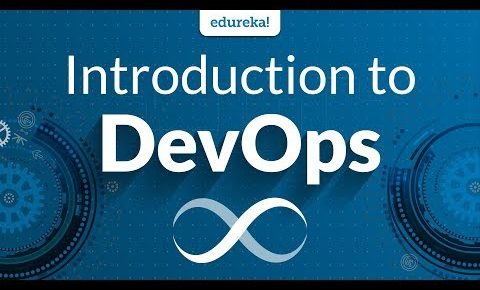
Introduction to DevOps | DevOps Tutorial for Beginners | DevOps Training | Edureka
** DevOps Training: https://www.edureka.co/devops Flat 20% Off (Use Code: YOUTUBE20) **
This DevOps Tutorial on “Introduction To DevOps” explains what is DevOps and how it works. This DevOps Tutorial for Beginners include the following topics:
1. What is DevOps?
2. DevOps Tools and Stages
3. DevOps Use-Cases
4. Hands-On (Build Pipeline Using Jenkins)
Edureka DevOps playlist: http://goo.gl/O2vo13
For doubts & queries on DevOps, post the same on Edureka Community: https://www.edureka.co/community/devops-and-agile
DevOps Podcast: https://castbox.fm/channel/id1684800
Facebook: https://www.facebook.com/edurekaIN/
Twitter: https://twitter.com/edurekain
LinkedIn: https://www.linkedin.com/company/edureka
#DevOpsTools #DevOpsTraining #DevOpsTutorial #DevOpsJenkins #Jenkins #JenkinsTutorial#JenkinsTraining #JenkinsPlugins #JenkinsBuildPipeline #JenkinsMasterSlave
How it Works?
1. This is a 4 Week Instructor led Online Course.
2. Course consists of 24 hours of online classes, 25 hours of assignment, 20 hours of project
3. We have a 24×7 One-on-One LIVE Technical Support to help you with any problems you might face or any clarifications you may require during the course.
4. You will get Lifetime Access to the recordings in the LMS.
5. At the end of the training you will have to complete the project based on which we will provide you a Verifiable Certificate!
– – – – – – – – – – – – – –
About the Course
Edureka’s DevOps online training is designed to help you master key tools of Devops lifecycle like Docker, Puppet, Jenkins, Nagios, GIT, Ansible, SaltStack and Chef used by a DevOps Engineer for automating multiple steps in SDLC. During this course, our expert DevOps instructors will help you:
1. Understand the concepts and necessities of DevOps
2. Understand the need for DevOps and the day-to-day real-life problems it resolves
3. Learn installation and configuration of common infrastructure servers like Apache, and Nginx for the Enterprise
4. Learn popular DevOps tools like Jenkins, Puppet, Chef, Ansible, SaltStack, Nagios and GIT
5. Implement automated system update, installations and deployments
6. Learn Virtualization Concepts
7. Configuration deployment and packaging, continuous integration using GIT
8. Fine tune Performance and set-up basic Security for Infrastructure
9. Manage server operations using Code which is popularly known as Infrastructure as a Code
10. Understand the need for and concepts of Monitoring and Logging.
Along with the above mentioned topics, to help you master the most popular DevOps tools, you will also receive 3 additional self-paced courses including presentations, class recordings, assignments, solutions for the following tools:
1: Ansible – Covers Introduction, Setup & Configuration, Ansible Playbooks, 37 Ansible Modules, Different Roles and Command Line usage. 2: Chef – Covers Introduction, Building the Cook Book, Node Object & Search, Data-bags, Chef environment, Roles, Deploying Nodes in Production and using the Open Source Chef Server.
3: Puppet – Covers Puppet Infrastructure & run-cycle, the Puppet Language, Environment defining Nodes and Modules, Provisioning a Web Server and Executing Modules Against A Puppet Master.
– – – – – – – – – – – – – –
Who should go for this course?
DevOps practitioners are among the highest paid IT professionals today, and the market demand for them is growing rapidly. With emergence of new job roles around DevOps philosophy, anyone aspiring to get into these new roles, can take up this DevOps course. Some of these roles are:
1. DevOps Architect
2. Automation Engineer
3. Software Tester
4. Security Engineer
5. Integration Specialist
6. Release Manager
– – – – – – – – – – – – – –
Project Work
1. Host a dummy webpage using Apache Web Server.
2. Write shell script which reports:
a) Various system configurations related to the user and the OS.
b) Data related to load on the server.
c) Top 5 processes with maximum number of threads.
d) Sort the services by memory
3. Install Nagios on a VM node for monitoring the various parameter of the VM.
For more information, please write back to us at sales@edureka.co or call us at IND: 9606058406 / US: 18338555775 (toll-free).
